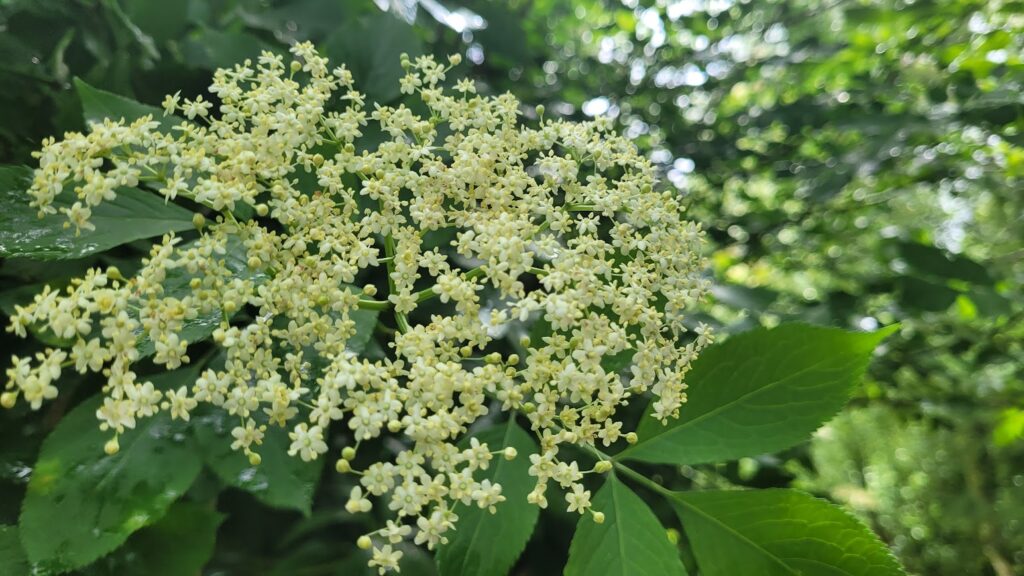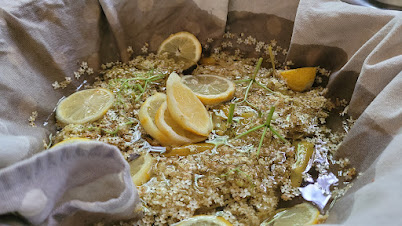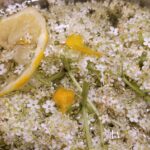Introduction to Elderflower Cordial
Delicious elderflower cordial is a refreshing drink made from the fragrant flowers of the elder tree (Sambucus nigra). This is an easy recipe suitable for all ages, making it a fun activity for the whole family. Elder trees commonly grow across Britain, Europe, and parts of North America. This homemade elderflower cordial recipe is a perfect way to enjoy the taste of summer year-round. With just a few ingredients, including fresh elderflowers, lemon juice, sugar, and water, you can create a fragrant syrup that can be used to make a variety of drinks and desserts. Whether you’re looking for a refreshing drink to serve at a summer party or a unique ingredient to add to your favorite recipes, elderflower cordial is a great choice.
Elderflower Cordial Recipe – In the High Weald
We are so lucky that we have elderflower growing in our garden. This particular plant grows up in the middle of a large rhodedendron bush on the corner of our lane. For the last three years I have been making a nice big batch of elderflower cordial and it beats anything you get in the shops. I love it with some sparkling water. I absolutely love elderflower cordial during the summer; its fragrant and refreshing qualities make it a seasonal delight.

Imagine a sip of summer, a delicate floral sweetness that dances on your tongue. That’s precisely what you get with this elderflower cordial recipe. This traditional British favourite is easier to make than you think, resulting in a refreshing drink perfect for warm days. Let’s dive into creating your own batch of liquid sunshine!
Why Make Your Own Elderflower Cordial?
Forget store-bought syrups loaded with artificial flavours and preservatives. Making your own elderflower cordial allows you to control the ingredients, ensuring a pure and natural taste. Plus, it’s a delightful way to capture the fleeting magic of elderflower season.
Our Simple Elderflower Cordial Recipe
Ingredients:
- 30 fresh elderflower heads
- 1.7 litres water
- 1.7 kg granulated sugar
- 100 grams citric acid (available from pharmacies)
- 2 unwaxed lemons
- Lemon zest for additional flavor
Instructions:
- Boil the Water: In a large saucepan, bring the water to a rolling boil. Remove from the heat.
- Dissolve the Sugar: Stir in all the sugar until it completely dissolves.
- Prepare the Lemons: Using a vegetable peeler, remove the zest from the lemons. Slice the lemons into rounds.
- Combine Ingredients: Once the sugar is dissolved, add the elderflower heads, lemon zest, lemon slices, and citric acid to the saucepan.
- Steep: Stir everything together, cover the saucepan, and leave it to steep for 24 hours.
- Strain: After 24 hours, strain the mixture through a muslin cloth or a clean tea towel into sterilised glass bottles.
- Store: Store your elderflower cordial in the refrigerator. Alternatively, you can keep it in a cool place, and it will last for a few months.
Foraging for Elderflowers
Foraging for elderflowers is a fun and rewarding experience, and with a few tips, you can ensure that you pick the best flowers for your homemade elderflower cordial. Look for elder trees with creamy white flowers that are in full bloom, and avoid trees that are near busy roads or have been sprayed with pesticides. The best time to pick elderflowers is on a sunny, dry morning, when the dew has evaporated and the flowers are at their most fragrant. Simply snip off the flower heads with scissors, leaving as little stalk as possible to avoid bitterness, and place them in a basket or bag to take home.
Ingredients and Equipment for Homemade Elderflower Cordial
To make homemade elderflower cordial, you will need the following ingredients:
- 1 kg granulated sugar
- 1 liter boiling water
- 2 large lemons, sliced
- 2 tablespoons citric acid (optional)
- 20-25 elderflower heads, stalks removed
You will also need the following equipment:
- A large saucepan
- A fine sieve or muslin cloth
- A large bowl or container
- Sterilised bottles with lids
- A funnel and ladle for bottling
Instructions:
- Place the elderflower heads in a large bowl.
- Pour the boiling water over the elderflower heads.
- Add the sliced lemons and citric acid (if using).
- Stir the mixture well and leave to infuse for 24 hours.
- After 24 hours, strain the mixture through a fine sieve or muslin cloth into a large saucepan.
- Add the granulated sugar to the saucepan and bring to a boil, stirring frequently to ensure the sugar dissolves completely.
- Once the sugar has dissolved, remove from heat and allow to cool.
- Use a funnel and ladle to bottle the cordial into sterilised bottles.
Tips for the Best Elderflower Cordial
- Choose the Right Elderflowers: Pick elderflowers on a sunny day when they are fully open and fragrant. Avoid flowers near busy roads or areas where pesticides may have been used. Ensure the flowers have not turned brown, as this indicates they are past their best and may not yield the best flavor for the elderflower cordial.
- Harvest at the right time: Elderflower season is short, so make sure to harvest when the flowers are at their peak. Usually late May and early June.
- Preserve Natural Yeasts: To maintain the natural yeasts crucial for fermentation and flavor, do not wash the elderflowers. Simply shake them gently to remove any insects or debris, as washing can remove the flavor.
- Sterilise your bottles: To ensure your cordial lasts, sterilise your bottles by washing them in hot, soapy water and then placing them in a low oven (160°C/320°F) for 10-15 minutes.

Frequently Asked Questions
How to make a simple elderflower cordial?
Simply boil water in a large pan, dissolve sugar, add elderflowers, lemon, and citric acid, stirring occasionally to ensure proper flavor extraction. Cover the mixture and let it infuse overnight for enhanced flavor and aroma. After 24 hours, strain the mixture.
Finally, pour the finished cordial into bottles.
Why do you need citric acid in elderflower cordial?
Citric acid acts as a preservative, extending the shelf life of your cordial. It also adds a tangy flavour that balances the sweetness. If fresh elderflowers are not available, you can use dried flowers as an alternative.
Should you wash elderflowers before making cordial?
It’s generally recommended to not wash elderflowers, as this can remove the pollen, which contributes to the flavour. Instead, gently shake the flowers to remove any insects. Edible flowers, like elderflowers, are prized for their unique taste and can significantly enhance the flavor of drinks and desserts.
What are the benefits of drinking elderflower cordial?
Elderflowers are believed to have various health benefits, including antioxidant and anti-inflammatory properties. Elderflower cordial is also a refreshing and hydrating drink, especially when diluted with sparkling water. The unique tastes of elderflower cordial make it a delightful addition to various recipes like cakes and desserts. Additionally, elderflower syrup is a versatile ingredient that can enhance desserts, drinks, and cocktails.
Exploring Elderflower Recipes
Elderflower cordial is a versatile ingredient that can be used in a variety of recipes, from refreshing drinks to delicious desserts. One popular way to enjoy elderflower cordial is to mix it with sparkling water and a squeeze of lemon juice for a light and revitalizing drink. This combination is perfect for hot summer days when you need a refreshing pick-me-up.
But the uses of elderflower cordial don’t stop there. You can also use it as a base for elderflower syrup, which can be drizzled over cakes, mixed into icings, or used to sweeten other desserts. For a unique twist, try making elderflower fritters by dipping elderflower heads in a light batter and frying them until golden brown. Another delightful option is elderflower and gooseberry jam, which pairs the floral notes of elderflower with the tartness of gooseberries. And for a celebratory touch, elderflower champagne is a fizzy, floral beverage that’s perfect for toasting special occasions.
Variations and Substitutions
While traditional elderflower cordial recipes call for fresh elderflowers, lemon juice, and sugar, there are many variations and substitutions you can try to create a unique flavor. For a citrusy twist, add a few slices of orange to the mixture. If you prefer a more natural sweetener, substitute honey for sugar, which adds a rich, floral sweetness to the cordial.
Experimenting with different types of citrus fruits, such as limes or grapefruits, can also create a different flavor profile. If fresh elderflowers are not available, dried flowers or elderflower extract can be used as substitutes. When making homemade elderflower cordial, citric acid plays a crucial role in preserving the cordial and giving it a tangy flavor. You can purchase citric acid at most pharmacies or online, or use lemon juice as a natural alternative. These variations allow you to customize your elderflower cordial to suit your taste preferences and available ingredients.
Serving Suggestions
- Dilute with still or sparkling water for a refreshing drink.
- Add to cocktails or mocktails for a floral twist.
- Mix with champagne for a summery touch to sparkling beverages.
- Mix with lemonade for a refreshing summer drink.
- Drizzle over lemon sorbet to enhance its flavor.
- Drizzle over ice cream or desserts.
- Add to a summer fruit salad.

Preserving and Storage Tips
To preserve your homemade elderflower cordial and keep it fresh for as long as possible, follow these storage tips:
- Store the cordial in sterilised bottles with tight-fitting lids in a cool, dark place.
- Keep the cordial away from direct sunlight and heat sources.
- Once opened, store the cordial in the fridge and use within 6 weeks.
- You can also freeze the cordial in ice cube trays or plastic bottles to preserve it for longer.
- To sterilise your bottles, wash them in hot soapy water and then rinse them with boiling water.
- Unopened bottles of elderflower cordial should be stored in a cool and dark place to maintain their quality.
Troubleshooting Common Issues
If you encounter any issues while making your homemade elderflower cordial, don’t worry! Here are some common problems and solutions:
- If your cordial is too sweet, you can dilute it with a little more water.
- If your cordial is too bitter, you can add a little more sugar.
- If you notice any mold or sediment in your cordial, discard it immediately and start again.
- If you find that your cordial is not fragrant enough, you can try adding a few more elderflower heads to the mixture.
- If you’re having trouble finding elderflowers, try looking in late spring or early summer, when they are in season. You can also try using dried elderflowers as a substitute.
Capture the Taste of Summer
Making your own elderflower cordial is a rewarding experience. It’s a taste of summer you can enjoy all year round. So, get out there, gather your elderflowers, and start creating your own sunshine in a bottle! For more culinary options, consider exploring other elderflower recipes like elderflower cake, elderflower and coconut ice cream, and elderflower fritters.
How to make Elderflower Cordial.
Elderflower Cordial Recipe
Equipment
- 1 large saucepan
Ingredients
- 30 Elderflowers
- 1.7 litres Water
- 1.7 kg Sugar
- 100 grams Citric Acid You can buy this at the chemist/pharmacy
- 2 Lemons
Instructions
- Bring the water to a boil in a large saucepan and take it off the heat.
- Stir in all the sugar.
- Remove the peel from the lemons with a vegetable peeler and cut the lemons into slices.
- Once the sugar has fully dissolved add the flowers, lemon peel and slices, and citric acid to the pot.
- Stir and leave covered for 24 hours.
- Strain the mixture through a muslin or teatowel.
Check out more recipes on the blog.
Conclusion and Next Steps
Making homemade elderflower cordial is a fun and rewarding experience that can be enjoyed by people of all ages. With just a few ingredients, including elderflower heads, sugar, and lemon juice, you can create a delicious and refreshing drink that’s perfect for hot summer days. Whether you’re a seasoned cook or a beginner, making elderflower cordial is a great way to get creative in the kitchen and enjoy the flavors of the season.
